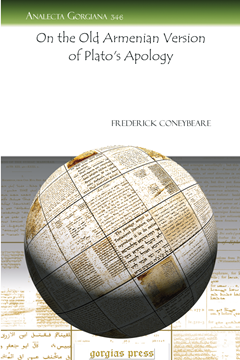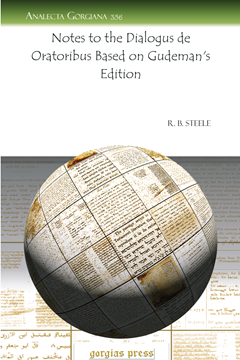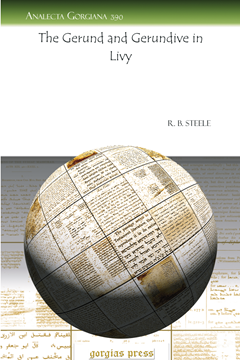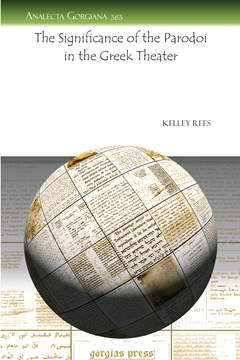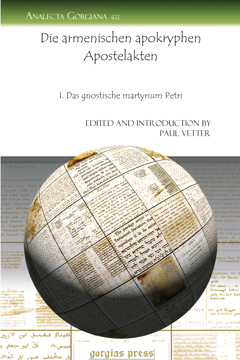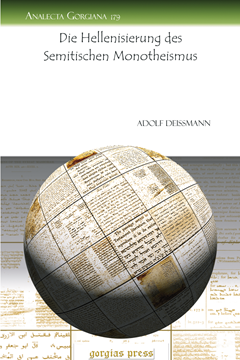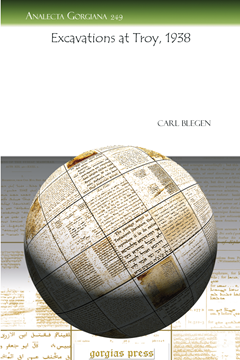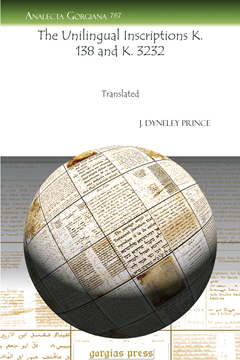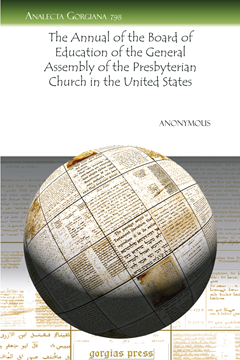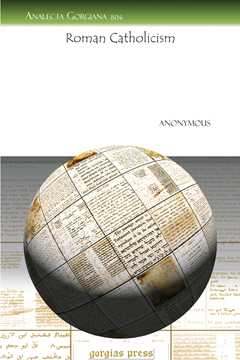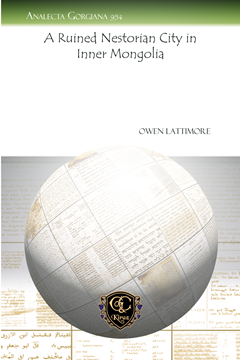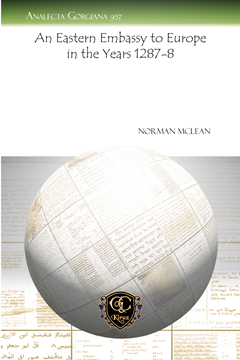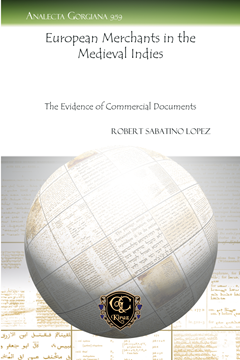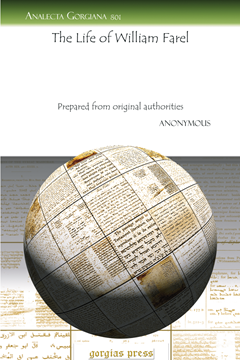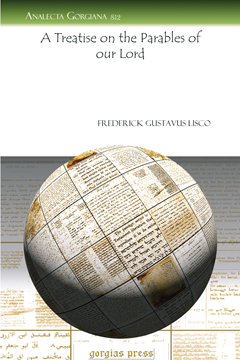Analecta Gorgiana
Analecta Gorgiana is a collection of long essays and short monographs which are consistently cited by modern scholars but previously difficult to find because of their original appearance in obscure publications. Carefully selected by a team of scholars based on their relevance to modern scholarship, these essays can now be fully utilized by scholars and proudly owned by libraries.
On the Old Armenian Version of Plato's Apology
Series: Analecta Gorgiana 346
ISBN: 978-1-60724-600-8
Frederick Coneybeare analyzes old Armenian codices of Plato's Apology in order to demonstrate the weakness of the chief codex used to support the Greek text.
$35.00 (USD) $21.00 (USD)
Notes to the Dialogus de Oratoribus Based on Gudeman's Edition
By R. B. Steele
Series: Analecta Gorgiana 356
ISBN: 978-1-60724-610-7
Reading notes and commentary to Tacitus' Dialogus de oratoribus, a little-known yet key work in Tacitus' ouvre.
$35.00 (USD) $21.00 (USD)
The Gerund and Gerundive in Livy
By R. B. Steele
Series: Analecta Gorgiana 390
ISBN: 978-1-60724-639-8
R. B. Steele classifies Livy's use of the gerund and gerundive in his history of Rome, providing insight into the regular useage of this rather irregular feature of Latin grammar.
$35.00 (USD) $21.00 (USD)
The Significance of the Parodoi in the Greek Theater
By Kelley Rees
Series: Analecta Gorgiana 363
ISBN: 978-1-60724-650-3
Kelley Rees examines the question of whether or not the parodoi of Greco-Roman theaters conventionally represented specific destinations relative to the city/ stage.
$35.00 (USD) $21.00 (USD)
Un recueil de sentences attribué à Isaac le Syrien
Edited with an Introduction by Marius Besson
Series: Analecta Gorgiana 401
ISBN: 978-1-60724-675-6
Marius Besson presents the critical text of two manuscripts containing an apophthegmatic text with sayings attributed to Isaac of Nineveh. The text also includes a separate apparatus with references to parallel texts in various early Christian documents.
$35.00 (USD) $21.00 (USD)
Die armenischen apokryphen Apostelakten I. Das gnostische martyrium Petri
Edited with an Introduction by Paul Vetter
Series: Analecta Gorgiana 411
ISBN: 978-1-60724-688-6
Paul Vetter presents the Armenian text, along with a Greek translation, of the “Gnostic Martyrdom of Peter” from the Apocryphal Acts of the Apostles. The article also includes an appendix in which Vetter describes the manuscripts used in the collation.
$35.00 (USD) $21.00 (USD)
Die syrische "Liturgie" des Kyriakos von Antiocheia
Edited with an Introduction by Karl Kaiser
Series: Analecta Gorgiana 422
ISBN: 978-1-60724-713-5
Kyriakos, Patriarch of Antioch, was an influential figure in the development of the Syriac Monophysite tradition. Karl Kaiser presents here a brief but important survey of his life and publishes the Syriac text of a liturgy attributed to Kyriakos.
$35.00 (USD) $21.00 (USD)
Die Hellenisierung des Semitischen Monotheismus
Series: Analecta Gorgiana 179
ISBN: 978-1-60724-272-7
Deissmann was a scholar well known for his work with the Greek of the New Testament. In this little volume he considers the Hellenization of Semitic monotheism. Primarily concerned with the changes after Alexander’s conquest, the book is a brief exploration of Greek religion in the aftermath of conquest. Semitic monotheism was, according to Deissmann, a new concept for the Greek world. Hellenistic outlooks had long been influenced by classical viewpoints. Into this cultural milieu the Judaic concept of monotheism made immediate inroads. This influence is explored primarily in linguistic form, including considerations of the Septuagint. Both Hellenists and Semitic scholars will find material of interest here. Observations made by Deissmann influenced later thought in this field. Stretching across disciplines, this study will interest cultural historians as well. Share the sense of discovery with this useful booklet.
$35.00 (USD) $21.00 (USD)
Jointed Dolls in Antiquity
Series: Analecta Gorgiana 233
ISBN: 978-1-60724-462-2
Kate Elderkin presents an enjoyable overview not only of the nature of children's dolls in Antiquity, but the customs surrounding their use and subsequent dedication when the owner reached adulthood.
$35.00 (USD) $21.00 (USD)
Excavations at Troy, 1938
By Carl Blegen
Series: Analecta Gorgiana 249
ISBN: 978-1-60724-478-3
The fifth of Carl Blegen's reports on the excavation of Troy for the American Journal of Archeology concentrating on detailed study of artifacts and finds on the citadel.
$35.00 (USD) $21.00 (USD)
Words for Color in the Rig Veda
Series: Analecta Gorgiana 315
ISBN: 978-1-60724-547-6
Edward Hopkins here addresses and debunks the color theory, which assumes that ancient peoples were unable to perceive shades of green and blue because they lack vocabulary parallel to our own words for color.
$35.00 (USD) $21.00 (USD)
The Sinner’s Ability to obey God, if he will
Two Sermons by Rev. Mr. Perkins, Montreal, Canada. National Preacher, September, 1833. J.& J. Harper, New York.
By Anonymous
Series: Analecta Gorgiana 782
ISBN: 978-1-61143-160-5
The article reviews two sermons on the freedom of sinners to obey God. The author declares that man can obey so long as he is able, stating the reverend’s point is obvious and flawed.
$35.00 (USD) $21.00 (USD)
The Unilingual Inscriptions K. 138 and K. 3232
Translated
Series: Analecta Gorgiana 767
ISBN: 978-1-61143-145-2
Three inscriptions are laid out, which directly relate to the Assyrian ceremony of the scapegoat. Many of the rites discusses in these inscriptions relate to those of the Israelites. Translations and commentaries are given of all three inscriptions.
$35.00 (USD) $21.00 (USD)
Notes on Recent Theories of the Origin of the Alphabet
By John Peters
Series: Analecta Gorgiana 768
ISBN: 978-1-61143-146-9
The author’s intent is to continue a search about the origins of the Phoenician alphabet and whether it has a connection to old Babylonian and Egyptian. Up until this point, no satisfactory connection has been made to the Babylonian syllabaries.
$35.00 (USD) $21.00 (USD)
On the Date of Zoroaster
Series: Analecta Gorgiana 771
ISBN: 978-1-61143-149-0
Wide diversity prevails with regard to the date which Zoroaster lived. This diversity is largely due to incongruities in ancient statements on the subject. One can reasonably conclude that he lived between the seventh and sixth centuries B.C.E.
$35.00 (USD) $21.00 (USD)
The Annual of the Board of Education of the General Assembly of the Presbyterian Church in the Unite
By Anonymous
Series: Analecta Gorgiana 798
ISBN: 978-1-61143-176-6
The reviewer praises an annual, comprised of a series of articles, as valuable for students entering the ministry. The author advocates modesty, hard work and piety amongst other virtues.
$35.00 (USD) $21.00 (USD)
Roman Catholicism
By Anonymous
Series: Analecta Gorgiana 804
ISBN: 978-1-61143-182-7
A scathing polemic against Roman Catholicism, the author uses logical and textual evidence to contradict Catholic rituals and beliefs.
$35.00 (USD) $21.00 (USD)
Cornelius Jansenius; and the Controversies on Grace, in the Roman Catholic Church
By Anonymous
Series: Analecta Gorgiana 789
ISBN: 978-1-61143-167-4
The author provides the biography of Cornelius Jansenius and describes his commentary, Augustinus, to explain Jansenius’s position on Grace in relation to Catholic doctrine. He concludes this history convicts the Catholic Church.
$35.00 (USD) $21.00 (USD)
A Ruined Nestorian City in Inner Mongolia
Series: Analecta Gorgiana 954
ISBN: 978-1-61143-871-0
Owen Lattimore, a historian of Central Asia, presents the first report on Kwei-hua, the ruined city of the Syriac-Ongut Turks.
$35.00 (USD) $21.00 (USD)
An Eastern Embassy to Europe in the Years 1287-8
Series: Analecta Gorgiana 957
ISBN: 978-1-61143-874-1
Rabban Sauma, a Syriac monk, travelled to Europe in 1287 as a diplomatic representative of the Mongols; this is his own account of his travels, the first translation into English.
$35.00 (USD) $21.00 (USD)
European Merchants in the Medieval Indies
The Evidence of Commercial Documents
Series: Analecta Gorgiana 959
ISBN: 978-1-61143-878-9
Commercial sources on journeying to the east after Marco Polo; the gradual closing of trade between Italy and China or India under the hostile or defensive rulers of the lands in between.
$35.00 (USD) $21.00 (USD)
The Life of William Farel
Prepared from original authorities
By Anonymous
Series: Analecta Gorgiana 801
ISBN: 978-1-61143-179-7
The reviewer examines a biography of Protestant Reformer William Farel. The book describes Farel’s departure from Catholicism and contributions to the efforts of Swiss Reformation, Zuingle in particular. His trails and successes are described.
$35.00 (USD) $21.00 (USD)
Memoir of the Rev. George Burder, author of “Village Sermons,” and Secretary of the London Missionar
By Henry Foster Burder, DD
By Anonymous
Series: Analecta Gorgiana 811
ISBN: 978-1-61143-189-6
The article reviews the memoir of Rev. George Burder. The reviewer outlines the reverend’s family, his entrance to the ministry, his shift into missionary work, his preaching, and his hardships. The reviewer judges his style and persona.
$35.00 (USD) $21.00 (USD)
A Treatise on the Parables of our Lord
Series: Analecta Gorgiana 812
ISBN: 978-1-61143-190-2
This article introduces and translates “A Treatise on the Parables of our Lord” by Rev. Fredrick Gustavus Lisco of Berlin. The treatise defines and traces the history of parables. Using critical sources, he explores New Testament parables.
$35.00 (USD) $21.00 (USD)
Remarks on the Epistles of Ignatius
By Anonymous
Series: Analecta Gorgiana 814
ISBN: 978-1-61143-192-6
The article describes and critiques the authenticity of the epistles of Ignatius. The author claims that the illegitimacy of letters that speak of prelacy erodes the basis for Episcopacy and Presbyterianism.
$35.00 (USD) $21.00 (USD)

